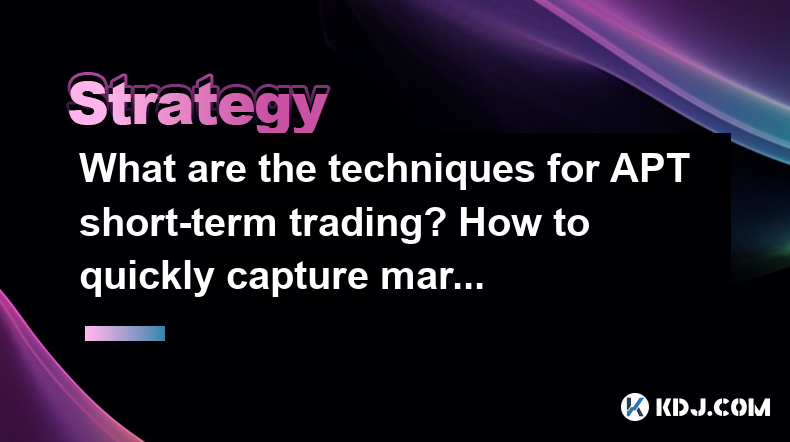-
 bitcoin
bitcoin $121833.232455 USD
-0.63% -
 ethereum
ethereum $4394.437030 USD
-2.00% -
 tether
tether $1.000570 USD
0.04% -
 bnb
bnb $1255.553465 USD
-3.73% -
 xrp
xrp $2.814944 USD
-1.59% -
 solana
solana $221.835346 USD
-2.40% -
 usd-coin
usd-coin $0.999869 USD
0.01% -
 dogecoin
dogecoin $0.249495 USD
-1.32% -
 tron
tron $0.336905 USD
-1.24% -
 cardano
cardano $0.816464 USD
-1.69% -
 chainlink
chainlink $22.130946 USD
-1.27% -
 hyperliquid
hyperliquid $44.208522 USD
-3.46% -
 ethena-usde
ethena-usde $1.000521 USD
0.02% -
 sui
sui $3.422897 USD
-2.51% -
 stellar
stellar $0.380164 USD
-1.31%
What are the techniques for APT short-term trading? How to quickly capture market fluctuations?
Use technical analysis, candlestick patterns, and real-time monitoring to quickly capture APT market fluctuations in short-term trading.
May 04, 2025 at 01:21 pm

Short-term trading in the cryptocurrency market, particularly with assets like Aptos (APT), requires a keen understanding of market dynamics and the ability to act swiftly. This article delves into the techniques used for APT short-term trading and how traders can quickly capture market fluctuations.
Understanding APT and Short-Term Trading
Aptos (APT) is a cryptocurrency that operates on the Aptos blockchain, known for its scalability and security features. Short-term trading involves buying and selling APT within a short period, often within a day or even minutes, to capitalize on small price movements. The goal is to generate profits from these rapid fluctuations.
Key Techniques for APT Short-Term Trading
Technical Analysis
Technical analysis is a cornerstone of short-term trading. It involves studying historical price charts and using various indicators to predict future price movements. For APT, traders often use the following tools:
- Moving Averages: These help identify trends by smoothing out price data over a specific period. For instance, a trader might use a 50-day moving average to gauge the overall trend of APT.
- Relative Strength Index (RSI): This momentum oscillator measures the speed and change of price movements. An RSI above 70 indicates that APT might be overbought, while below 30 suggests it might be oversold.
- Bollinger Bands: These bands help identify volatility and potential price breakouts. When APT's price touches the upper band, it might be overbought, and when it touches the lower band, it might be oversold.
Candlestick Patterns
Candlestick patterns provide visual cues about market sentiment and potential price reversals. Common patterns used in APT trading include:
- Doji: Indicates indecision in the market, often signaling a potential reversal.
- Hammer: Suggests a bullish reversal after a downtrend.
- Shooting Star: Indicates a bearish reversal after an uptrend.
Traders should look for these patterns on different timeframes, such as 1-minute, 5-minute, or 15-minute charts, to make quick trading decisions.
Volume Analysis
Volume is a critical factor in short-term trading. High trading volume can confirm the strength of a price move. For APT, traders should:
- Monitor volume spikes, which can indicate strong buying or selling pressure.
- Use volume indicators like the Volume Weighted Average Price (VWAP) to assess the average price APT has traded at throughout the day, weighted by volume.
Scalping
Scalping is a technique where traders aim to profit from small price changes. For APT, scalpers might:
- Set tight stop-loss orders to minimize potential losses.
- Use high leverage to amplify gains from small price movements, though this increases risk.
- Focus on liquid markets to ensure quick entry and exit from trades.
How to Quickly Capture Market Fluctuations
Real-Time Monitoring
To capture market fluctuations effectively, traders must monitor APT's price in real-time. This involves:
- Using trading platforms that offer real-time data and customizable alerts.
- Keeping an eye on news and events that could impact APT's price, such as regulatory announcements or technological updates.
Algorithmic Trading
Algorithmic trading uses computer programs to execute trades based on predefined criteria. For APT, traders might:
- Develop algorithms that automatically buy or sell APT when certain technical indicators are met.
- Use high-frequency trading strategies to capitalize on small price movements within milliseconds.
Arbitrage
Arbitrage involves buying APT on one exchange where the price is lower and selling it on another where the price is higher. To execute this strategy:
- Monitor price differences across multiple exchanges.
- Use automated tools to quickly execute trades and capture the price differential.
News Trading
News trading involves reacting to market-moving news. For APT, traders should:
- Stay updated with news related to the Aptos blockchain and broader cryptocurrency market.
- Use news feeds and social media to get real-time updates.
- Be ready to enter or exit trades quickly based on the impact of the news on APT's price.
Practical Steps for APT Short-Term Trading
Setting Up a Trading Platform
To start trading APT short-term, follow these steps:
- Choose a reputable exchange: Select an exchange that supports APT trading and offers the necessary tools for short-term trading.
- Set up an account: Complete the registration process, including KYC verification if required.
- Fund your account: Deposit funds into your exchange account to start trading.
Configuring Trading Tools
Once your account is set up, configure your trading tools:
- Install trading software: Use platforms like TradingView or MetaTrader for advanced charting and analysis.
- Set up indicators: Add moving averages, RSI, and Bollinger Bands to your charts.
- Create alerts: Set price alerts to notify you of significant movements in APT's price.
Executing Trades
To execute trades effectively:
- Analyze the market: Use technical analysis to identify potential entry and exit points.
- Place orders: Use market or limit orders to buy or sell APT based on your analysis.
- Monitor trades: Keep an eye on your open positions and be ready to adjust or close them based on market conditions.
Managing Risk
Risk management is crucial in short-term trading:
- Set stop-loss orders: Define the maximum loss you are willing to accept on each trade.
- Use position sizing: Determine the size of your trades based on your overall trading capital and risk tolerance.
- Diversify: Avoid putting all your capital into APT; consider trading other cryptocurrencies as well.
Frequently Asked Questions
Q: How much capital do I need to start short-term trading APT?A: The amount of capital needed depends on your trading strategy and risk tolerance. For scalping and other short-term strategies, starting with a few hundred dollars can be sufficient, but having more capital allows for greater flexibility and risk management.
Q: Can I use automated trading bots for APT short-term trading?A: Yes, automated trading bots can be used for APT short-term trading. These bots can execute trades based on predefined criteria, allowing you to capitalize on market fluctuations without constant monitoring. However, ensure the bot is well-tested and aligned with your trading strategy.
Q: What are the risks associated with short-term trading APT?A: Short-term trading APT carries several risks, including market volatility, slippage, and the potential for significant losses due to rapid price movements. It's essential to use proper risk management techniques and be aware of the market conditions at all times.
Q: How do I choose the right time frame for APT short-term trading?A: The choice of time frame depends on your trading style and goals. For very short-term trading, 1-minute or 5-minute charts may be suitable. For slightly longer-term trades, 15-minute or 1-hour charts could be more appropriate. Experiment with different time frames to find what works best for you.
Disclaimer:info@kdj.com
The information provided is not trading advice. kdj.com does not assume any responsibility for any investments made based on the information provided in this article. Cryptocurrencies are highly volatile and it is highly recommended that you invest with caution after thorough research!
If you believe that the content used on this website infringes your copyright, please contact us immediately (info@kdj.com) and we will delete it promptly.
- Avalanche, BLAZ, and Presale Opportunity: Catching the Next Wave in DeFi
- 2025-10-10 18:45:17
- Analyst's Crystal Ball: Will BRETT Mirror PEPE's Moonshot?
- 2025-10-10 18:45:17
- Token Economy, AI Inference, and the New Gold Rush: Decoding the AI Investment Boom
- 2025-10-10 18:50:01
- Dogecoin, Pepe Coin, and Remittix: A New York Minute on Crypto Trends
- 2025-10-10 18:25:14
- Pudgy Penguins Price Prediction: Cup-and-Handle Pattern Hints at Breakout?
- 2025-10-10 18:50:01
- Solana, Ozak AI, and the Crypto Market: Navigating the Hype
- 2025-10-10 18:50:01
Related knowledge

Practical parameter settings for a Bitcoin multi-timeframe moving average system
Sep 18,2025 at 10:54pm
Optimizing Timeframe Combinations for Bitcoin Trading1. Selecting appropriate timeframes is crucial when building a multi-timeframe moving average sys...

How can I filter out false breakouts in Dogecoin high-frequency trading?
Sep 22,2025 at 01:00am
Understanding False Breakouts in Dogecoin Trading1. A false breakout occurs when Dogecoin's price appears to move beyond a defined support or resistan...

Techniques for identifying tops and bottoms in the Bitcoin on-chain NVT model
Sep 20,2025 at 07:54pm
Understanding the NVT Model in Bitcoin Analysis1. The Network Value to Transactions (NVT) ratio is often described as the 'P/E ratio' of the cryptocur...

What does the surge in open interest in Bitcoincoin futures mean?
Sep 20,2025 at 11:18pm
Understanding the Surge in Dogecoin Futures Open Interest1. A surge in open interest within Dogecoin futures indicates a growing number of active cont...

How can I use the Ethereum USDT premium to gauge market sentiment?
Sep 18,2025 at 11:55pm
Understanding the Ethereum USDT Premium1. The Ethereum USDT premium refers to the price difference between USDT (Tether) traded on Ethereum-based plat...

What should I do if Ethereum staking yields decline?
Sep 20,2025 at 06:18am
Understanding the Causes Behind Declining Ethereum Staking Yields1. The Ethereum network transitioned to a proof-of-stake consensus mechanism with the...

Practical parameter settings for a Bitcoin multi-timeframe moving average system
Sep 18,2025 at 10:54pm
Optimizing Timeframe Combinations for Bitcoin Trading1. Selecting appropriate timeframes is crucial when building a multi-timeframe moving average sys...

How can I filter out false breakouts in Dogecoin high-frequency trading?
Sep 22,2025 at 01:00am
Understanding False Breakouts in Dogecoin Trading1. A false breakout occurs when Dogecoin's price appears to move beyond a defined support or resistan...

Techniques for identifying tops and bottoms in the Bitcoin on-chain NVT model
Sep 20,2025 at 07:54pm
Understanding the NVT Model in Bitcoin Analysis1. The Network Value to Transactions (NVT) ratio is often described as the 'P/E ratio' of the cryptocur...

What does the surge in open interest in Bitcoincoin futures mean?
Sep 20,2025 at 11:18pm
Understanding the Surge in Dogecoin Futures Open Interest1. A surge in open interest within Dogecoin futures indicates a growing number of active cont...

How can I use the Ethereum USDT premium to gauge market sentiment?
Sep 18,2025 at 11:55pm
Understanding the Ethereum USDT Premium1. The Ethereum USDT premium refers to the price difference between USDT (Tether) traded on Ethereum-based plat...

What should I do if Ethereum staking yields decline?
Sep 20,2025 at 06:18am
Understanding the Causes Behind Declining Ethereum Staking Yields1. The Ethereum network transitioned to a proof-of-stake consensus mechanism with the...
See all articles

























![Web3 Crypto Market Morning Report: Fomo on the Bnb chain continues, Binance launches the chain-sweeping platform Meme Rush, the market value of Xiuxian exceeds 40 million U.S. dollars, OK Binance business war begins [Vic TALK Issue 1437] Web3 Crypto Market Morning Report: Fomo on the Bnb chain continues, Binance launches the chain-sweeping platform Meme Rush, the market value of Xiuxian exceeds 40 million U.S. dollars, OK Binance business war begins [Vic TALK Issue 1437]](/uploads/2025/10/10/cryptocurrencies-news/videos/web-crypto-market-morning-report-fomo-bnb-chain-continues-binance-launches-chainsweeping-platform-meme-rush-market-xiuxian-exceeds-dollars-binance-business-war-vic-talk-issue/68e861c5dbd1c_image_500_375.webp)
















































